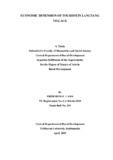Please use this identifier to cite or link to this item:
https://elibrary.tucl.edu.np/handle/123456789/2212| Title: | Economic dimension of Tourism in Langtang village |
| Authors: | Lama, Nirdesh Bal |
| Keywords: | tourism;Economic dimension |
| Issue Date: | 2019 |
| Publisher: | Department of Rural Development |
| Abstract: | Tourism industry provides products and services to the internal and foreigncustomers, generates profits to the country, all the while creating employmentopportunities to the host communities and nation.Nepal’s economy largely dependson tourism and nature based tourism is its backbone. Tourism accounts for 7.5 percentof Nepal’s GDP and 6.4 percentof employment (WTTC, 2017).The Himalayas andthe scenic beauty of Nepal are the prominent attractions to the tourists. With itsbreathtaking landscapes,snow-capped mountainsand friendly people, it has long beenknown asheaven on the earth.Langtangvillage lying at the heart of Langtang trek hasseen flourish in tourism post 1980, yet the scientific researches and assessment havebeen scarce. In this background this study has aimed to analyze the economicdimension of tourism in Langtangvillage.The specific objectives of the study are, toassess thetourism services in Langtang village, and to analyze the economy generatedby the tourism. Exploratory and descriptiveresearch designhave been employed in this study.For thestudy, both qualitative and quantitative data have beencollected through primary andsecondary data sources. The respondents' age, sex, occupation, income earned hasbeen quantitative in nature,andhow they are dependent on tourism, problems andchallenges associated, and other related information is qualitative. The primarysources of data were Household Survey Questionnaire, Key Informants Interview(KII), and Observation Checklist. The secondary sources were published andunpublished hard and soft copies of scholarly articles, books, academic thesis,journals, internet, reports, etc.The universe for this research is 152 households ofLangtang village(CBS, 2011).Simple random sampling method hasbeenemployedto select41 household samples with 90% level of confidence and 5% margin of error.The studyhas used the datacollected from techniques namely; Household Survey,Key-Informants Interview, and Observationby using questionnaire, KII guidelinesand checklist as toolsrespectively. Assessing the tourism services in Lantang village, the earnings were made frommainly hotel business (88 percent), tea-shops (8 percent), and few had porters (4percent). In majority, about 58.5 percent tourists came for trekking, 19.5 percent for vi site-seeing, and 9.8 percent for mount-climbing and remaining others forphotography, and volunteer works. And regarding the economy generated by tourism in Langtang village, this studyrevealed that 51% of the households had primary source of income from tourismfollowed by 39% from foreign employment. Every households made some monthlyincome through tourism, among which about 85.4 percent households could earnmore than 40 thousand NPR, with the lowest earners about 4.9 percent making upto20 thousand from this sector. These very businesses were run with the investmentmade with upto 5 lakhs by 14 percent, 5.1 to 10 lakhs by 10 percent, 10.1 to 15 lakhsby 12 percent, with above 15 lakhs of investment by 5 percent of the households. Interms of generation of employment, the businesses were run mainly employing thefamily members with 24 percent households running business by a single person, 12percent employing 2 members, 2 percent employing 3, and 3 percent employing morethan 3 members. Based on the findings, this study concludes that tourism is one of the importantsources of economy in Langtang village. Many households make significant incomethrough conducting businesses such as hotel, restaurants, guide and pottery service,trekking service and several others. But the scale of operation, quality tourismproducts, and other amenities are lacking for the optimum growth of this sector in thisregion. It is recommended to the community that collective bargains could be made tothe governments for improving and investing more on tourism sector, concernedpolicy makers could extend helping hands to the investors in tourism sector inLangtang village through tax rebates, subsidies, which could attract more tourists intothe village, and the local governments should first identify the potential tourismattractions, make plan and manage resources to preserve, and present them inattractive manner. . |
| URI: | http://elibrary.tucl.edu.np/handle/123456789/2212 |
| Appears in Collections: | Rural Development |
Files in This Item:
| File | Description | Size | Format | |
|---|---|---|---|---|
| THESIS.pdf | 218.19 kB | Adobe PDF |  View/Open |
Items in DSpace are protected by copyright, with all rights reserved, unless otherwise indicated.
